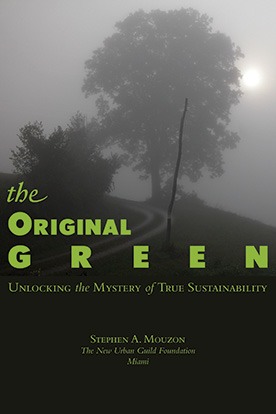search the Original Green Blog

They’re the thinnest and smallest of a city’s elemental parts, but “frontages,” a geeky planning word for the space between the front windows and doors of a building and a civic space or thoroughfare, do more to create or kill value in most cities than any other part of the city. Rarely more than a couple dozen feet deep, and often as thin as a few inches, the total acreage of frontages in a traditionally-planned town is less than that of thoroughfares, and is tiny compared to civic spaces and building lots, which are the other three elemental parts. Yet they make the greatest difference in the vitality and sustainability of the city.
Along a thoroughfare, the frontage is divided into the public frontage, which is located on the thoroughfare’s right-of-way (including sidewalks and usually street trees) and the private frontage, which is the part of the building lot between the property line and the front windows and doors of the building. When buildings front directly onto civic spaces (such as plazas), however, the frontage is simply the thickness of the front wall and cornice of the building. The frontage isn’t very tall, either; the part that drives vitality and value extends no more than three stories high.
Walk Appeal

Healthy frontages create value by building high
Walk Appeal; unhealthy ones do not.
Walk Appeal is that characteristic of a path which entices people to keep on walking, sometimes for miles, rather than stopping short. Enhancing Walk Appeal is a frontage’s primary job. A decade or two ago, achieving high Walk Appeal was considered an art form, but now we know it’s simpler than that. Much of it is simply geometry, and is therefore measurable. Other characteristics of Walk Appeal are immeasurable, but are equally real. And the impact of
Walk Appeal can be startling, meaning the difference between failure, survival, or thriving to neighborhood businesses. One other thing… as this image illustrates, places with great Walk Appeal typically have strong Bike Appeal as well, and allow each mode of transportation to coexist and thrive. Basically, Walk Appeal is a good indicator of a friendly place for all sorts of self-propelled transportation.
Thin Frontages

parks are great and necessary places in a city, but you can’t build
a city out of nothing but parks
nor can they provide places to live, work or shop
Thinner frontages create more sustainable urbanism and enhance Walk Appeal.
When buildings are placed closer to civic spaces or thoroughfares, several benefits accrue. But one word of warning: pulling buildings to the street brings screams of protests from the Landscape Urbanists, such as I witnessed at CNU19 in Madison, Wisconsin when Charles Waldheim proclaimed “whenever you insist on pulling buildings to the street, you lose!” I asked “you lose what?” several times, but he turned away and never responded. Waldheim and his colleagues want the freedom to place architecture wherever they want it in the landscape. They are masters at beautiful parks, but this is no way to build a sustainable city. He repeatedly cited Detroit’s Lafayette Park as a sterling example, but when we visited a year ago during the first Lean summit, nobody was there. Literally, there was not a single person on the streets other than us. It was beautiful, if you like Miesian architecture in a garden, but had very low Walk Appeal, as was evident because nobody was walking. But if you’re more interested in building sustainable urbanism, here are some of the benefits of thinner frontages:
Nourishability

who says an edible garden can’t be lovable?
Thinner frontages set the stage for more nourishable places by leaving more space in the rear.
Someday, we’ll build an agricultural aesthetic people other than gardeners will love. When that happens, we’ll be able to plant edible frontage gardens. Until then, edible gardening that enhance the nourishability of a place will likely be restricted by many cities to outdoor rooms hidden from public view. So the closer a building is to the front of the lot, the more room there is on all but the most urban lots for edible gardens behind the frontage.
Accessibility
Buildings closer to the sidewalk are more interesting to walk past than those further away, enhancing Walk Appeal.
Like Nourishability, this accessibility benefit is no more complex than third grade geometry. Walking close to a building is more interesting than walking further away for at least two reasons: your view changes more quickly, and you’re able to see more details of the building. Additionally, you may be close enough to speak with someone on the edge of the building. Making a walk substantially more interesting may make the difference between someone walking and driving, giving them more choices of means of access.
Serviceability

there are many necessities of life, and all can be within an
appealing walk of your home
Why put any buffer between people on the sidewalk and businesses hoping to serve them?
The worst offenders are shopping malls surrounded by seas of parking, and they’re dying across the country. Second worst are strip commercial buildings with parking lots in front. When is the last time you’ve walked to a strip commercial establishment? A sustainable place must be serviceable, so that you can walk to the daily services of life in your neighborhood, and that works best when commercial or mixed-use buildings are pulled right up to the sidewalk, with nothing screening storefronts or signs from people walking by.
Securability

eyes on the street translate directly into
people on the street at night, a strong sign
of a secure place
We’ve known since Jane Jacobs that “eyes on the street” make it more secure. Be sure they’re close enough.
Again, this is third grade geometry. The closer people are to the street, the better they can see and help supervise what happens there.
Adaptability
Thinner frontages allow buildings to be adapted to more uses over time.
Buildings pulled closer to a thoroughfare or civic space can be used for more things over time than those further back. Consider the two extremes: buildings built directly on the sidewalk can be almost anything: civic, retail, offices, residential (townhomes), lodging, industrial, or even storage in those inevitable low points all urbanism faces at some points in the future. At the other extreme, a building located at the end of a five-mile driveway is likely to be one of two things: either a very wealthy person’s estate home, or the chemical plant so located that it can blow up and not kill everyone in town. When buildings are adaptable to more uses over time, they usually last longer.
I could go on, as properly designed frontages can influence the lovability and frugality of buildings as well, but you get the picture. Just as a rudder can steer a ship many times its size, nothing steers the prosperity of a town or city like well-designed frontages. Simply put, they are the arteries of urbanism.
~Steve Mouzon

You'll receive an email from me with the subject line "Mouzon Design: Please Confirm Subscription." Click Yes to confirm your subscription for Walk Appeal book updates.



